
Posted on April 3, 2020 by Faith M. Smith and Robert Rozanksy
There is a virtually limitless supply of energy right beneath us: geothermal heat. The Earth’s core holds heat that radiates out to the subsurface. This heat can be harnessed for a variety of uses including electricity generation, heating and cooling of buildings, and other industrial and hybrid applications. Geothermal energy is clean, safe, and renewable. Because geothermal electricity is reliable, always-on energy, it is an excellent match for a grid replete with intermittent renewables like wind and solar energy.
Geothermal technologies have been employed for over one hundred years. But while wind and solar energy have grown rapidly over the past few decades, geothermal has struggled to scale up beyond niche applications. Geothermal energy’s relatively slow growth can be attributed to a combination of unmet technical challenges and policy barriers, and an inability to fully leverage state and federal renewable energy policies that have boosted wind and solar energy’s growth.
With that said, geothermal energy has immense potential to contribute to our clean energy future. The U.S. Department of Energy’s recent GeoVision report estimates that geothermal electricity generation could increase by 26-fold in the United States by 2050 if the industry can overcome the hurdles before it (Figure 1).1 It will take a coalition of actors to realize this cleaner future, and the federal government should be a leader in these efforts. This paper provides a brief introduction to geothermal energy and identifies solutions that the federal government could pursue to unlock this vast, renewable energy resource.
Key Takeaways:
Figure 1: U.S. Potential for Enhanced Geothermal Systems
Dots Indicate Existing Hydrothermal Sites

Shaded Regions Are Potentially Suitable for EGS
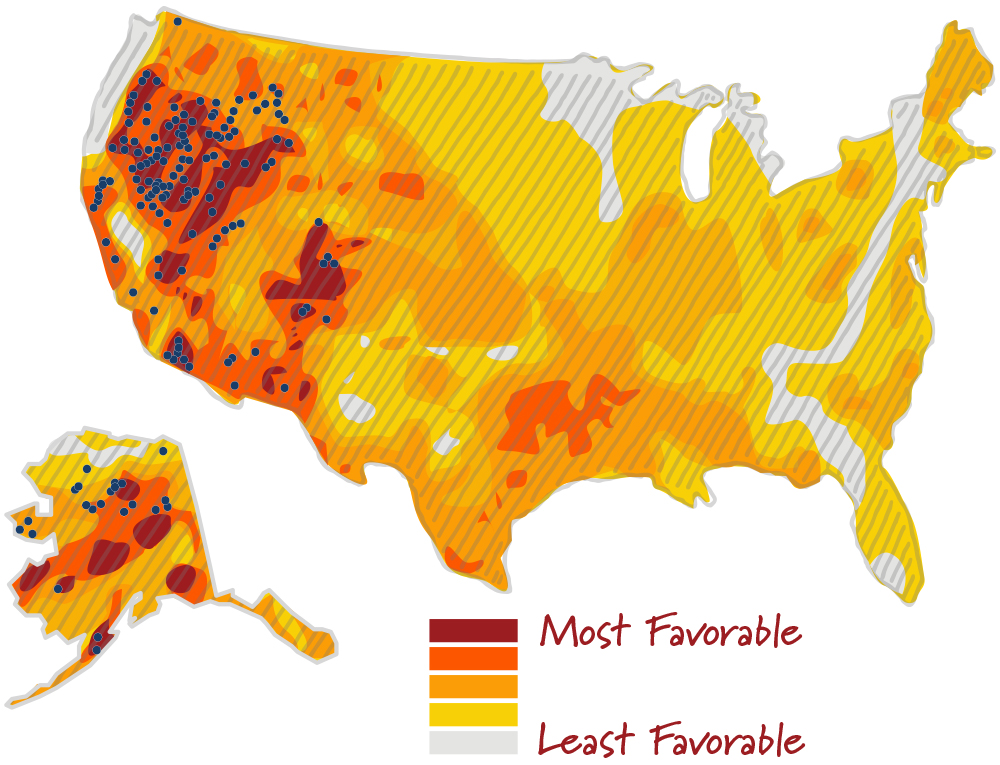
Geothermal energy is heat that radiates from the core of the Earth to the subsurface, produced by the decay of radioactive materials and residual heat from the planet’s formation. Geysers, hot springs, volcanoes, and fumaroles are all locations where geothermal energy reaches all the way to the Earth’s surface. It is easier to access geothermal resources in these locations, but geothermal resources are actually available anywhere if one drills deep enough. Geothermal energy, like wind and solar energy, is an inexhaustible natural resource.
Geothermal energy can be harnessed for a variety of applications. Power plants can use water heated by geothermal energy to produce steam, spin a turbine, and generate electricity. Homes and businesses can use the difference between surface and subsurface temperatures to draw or deposit energy to heat or cool buildings. Cities can circulate geothermally-heated water among buildings to provide heat or hot water. Other industries including manufacturing, agriculture, and mining can put geothermal resources to specific uses as well. Applications of geothermal energy that draw geothermally heated water and use it directly to provide a service are known as direct use.
Most commonly, geothermal energy is used for utility-scale electricity generation and has been harnessed for this purpose since 1904, beginning in Tuscany, Italy. In the United States, electricity from geothermal energy was first generated in 1922 in the Geysers region of California.3 Pacific Gas and Electric constructed the first utility-scale geothermal power plant in 1960 in the same region.4 Currently, there are thirteen operating power plants there, which generated an estimated 5,000 GWh of electricity in 2017.5 Today, the United States is the global leader in geothermal electricity capacity and generation.
Geothermal power plants harness energy from the subsurface in two ways: from naturally accessible hydrothermal resources and enhanced geothermal systems (EGS) that tap into otherwise-inaccessible resources. The vast majority of current U.S. geothermal electricity generation comes from hydrothermal resources, but EGS resources offer an enormous opportunity for growth.
Hydrothermal Power
Hydrothermal resources are hot underground reservoirs filled with or emitting water or steam relatively close to the surface. Hot steam or water can be used by a hydrothermal power plant to generate electricity, either by directly spinning a turbine or by heating a second, working fluid that spins a turbine.6 The utility of a hydrothermal resource is dependent on three main characteristics: heat, fluid, and permeability at depth.7
Enhanced Geothermal Systems
Enhanced or engineered geothermal systems (EGS) create opportunities to use hot, dry rock by enhancing the permeability of a specific geology or by adding water. EGS developers drill wells and inject water, and sometimes other chemicals, at high pressures to stimulate fractures. After permeability has been improved to increase fluid circulation, hot water can be drawn to the surface through a production well and used for electricity generation. EGS also has the potential to support direct use applications, described further below.
Geothermal energy can also provide heating and cooling services. There are two main technologies in this area: geothermal heat pumps (GHPs) and geothermal district heating.
Geothermal Heat Pumps
Geothermal heat pumps (GHPs) can be used to heat or cool buildings by leveraging the difference between the ambient temperature in a building and that in the ground at shallow depths — i.e., several tens to hundreds of feet below the surface — where it is typically between 45 and 75 degrees Fahrenheit. GHPs consist of a series of water-carrying pipes buried at these shallow depths; a traditional heating, ventilation, and air conditioning (HVAC) system at the surface; and a heat pump to transfer energy between the two. GHPs can serve as a clean, reliable, and grid-independent alternative to traditional gas- or electric-powered heating and cooling systems.8 As of 2016, the total installed capacity of GHP systems in the U.S. was 16,800 MWth, or about two million homes.9
Geothermal District Heating
Geothermal district heating systems draw heated water from hydrothermal or engineered subsurface reservoirs to provide hot water and heating services to a part of a city or town. District heating is a direct use application of geothermal energy. The country’s first geothermal district heating system has been operating since the early 1890s in Boise, Idaho. A district heating system replaces the need for individual buildings to provide heat or hot water using gas or electricity. Most existing district heating systems are powered by fossil fuels. As with GHPs, geothermal heating offers advantages with respect to alternatives in terms of carbon emissions, reliability, and energy security.10 As of 2016, the U.S. had 21 operational district-heating systems, amounting to a total installed capacity of 100 MWth, or about ten thousand homes.11
Geothermal heat can be used for direct use industrial applications such as low-emission hydrogen production; cement, aggregate, and concrete drying; and fabric, pulp, paper, and lumber processes. Agriculture direct use applications of geothermal energy include food processing, greenhousing,
and fish farming.
Applications utilizing geothermal resources for energy storage technologies are also being explored by government and private researchers. For example, Oak Ridge National Laboratory in Tennessee is working on a thermal energy storage technology that uses underground storage tanks to reduce peak electricity demand by 37% in homes, while balancing the grid.12 The technology is placed at minimal depths to reduce drilling costs as well.13
Furthermore, resources in geothermal brine can be co-produced alongside energy extraction for additional value streams. For instance, lithium carbonate found in geothermal brine can be used for battery manufacturing and was valued at $13,900 per metric ton in 2017.14
Figure 6: Geothermal Co-production
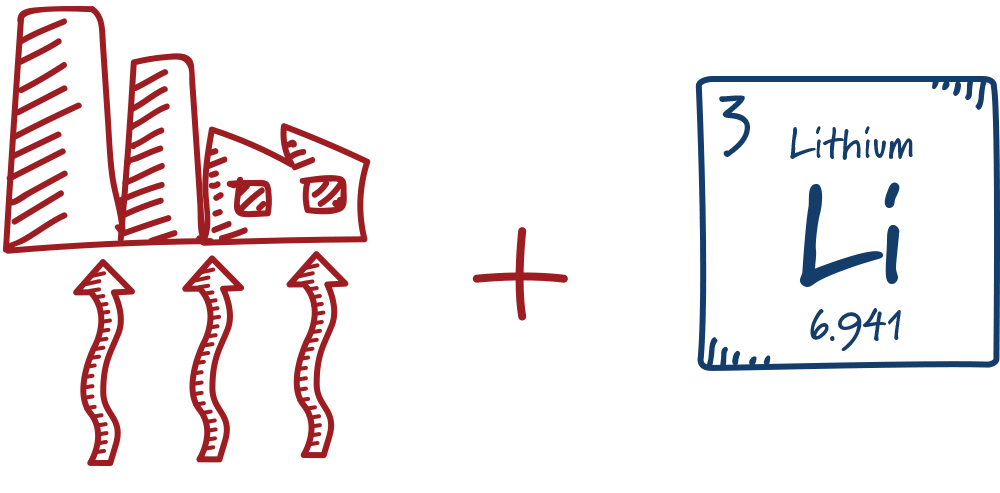
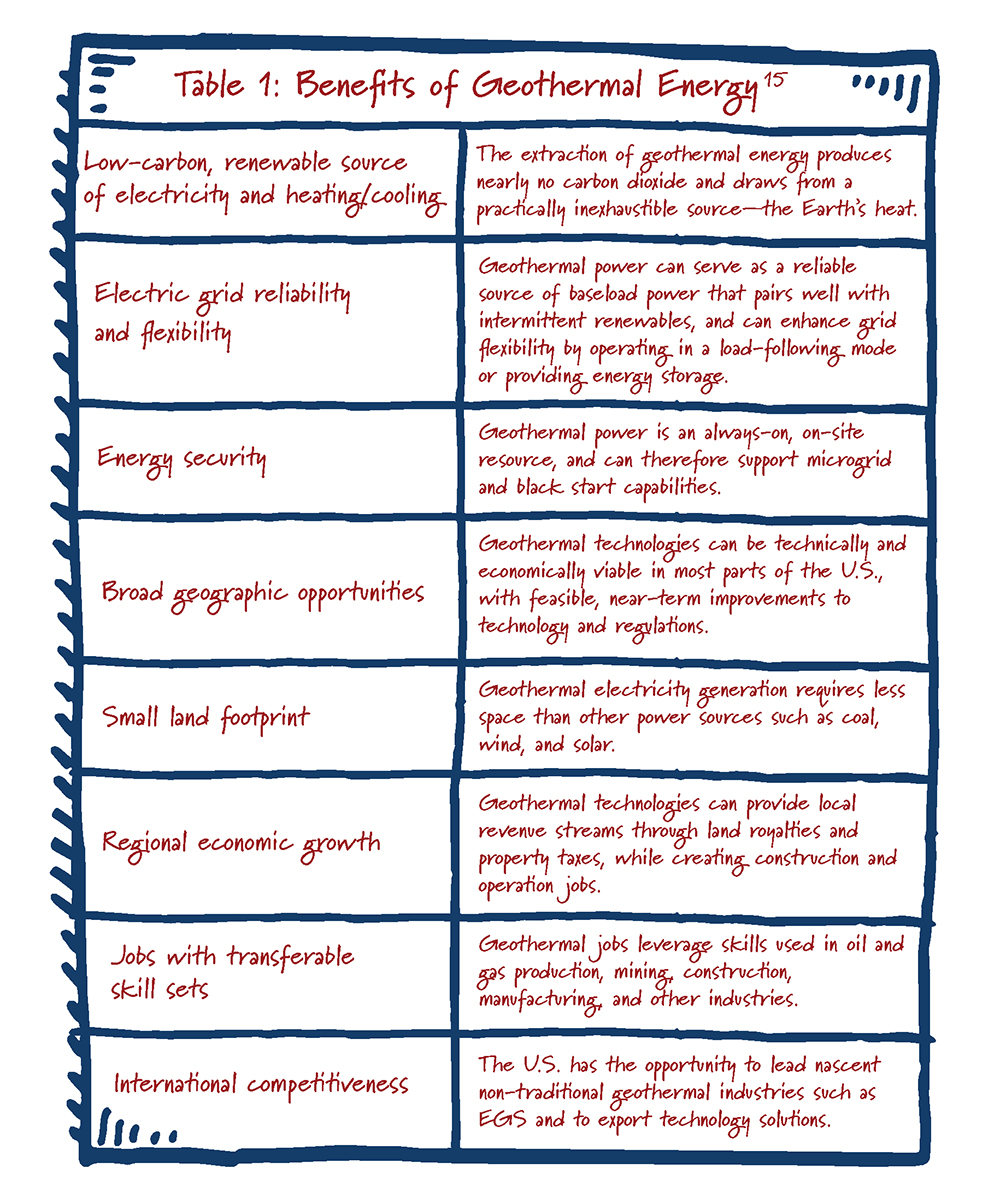
While geothermal power is a clean and renewable energy it does have environmental impacts that should be considered by developers and policymakers.
A minority of geothermal power plants have open-loop configurations that may allow modest amounts of gases trapped underground, including hydrogen sulfide, ammonia, and CO2, to be emitted into the atmosphere. The Intergovernmental Panel on Climate Change (IPCC) estimates geothermal lifecycle greenhouse gas emissions are on par with solar PV and 10-20 times less than those of natural gas, oil, and coal.16
Induced seismicity is perhaps the highest-profile environmental impact of EGS. When EGS developers inject and reinject fluids into the subsurface, there is a risk of inducing seismic events, or small earthquakes, typically on the order of 1 to 3.5 on the Richter scale. Induced seismicity can be mitigated through monitoring, modeling, and siting practices and by following DOE’s induced seismicity protocol.17
Finally, geothermal power development may pose risks to water quality due to contamination from chemicals injected for EGS or increased flows of other subsurface substances, although no such instances had been recorded as of 2012.18 Geothermal development may lead to increased water consumption due to evaporation in some power generation processes and may require access to remote or ecologically sensitive land areas. Assessments of these risks and ways to minimize them are further discussed in DOE’s 2013 Buried Treasure brochure and other sources.19A,19B,19C
The geothermal energy industry in the United States is concentrated in the west, especially in California (home to the largest producing field) and Nevada. It is composed of a handful of companies, which are identified in the map below (Figure 7).20 The industry is growing slowly. Two Power Purchase Agreements (PPAs) were signed in California by Ormat Technologies, Inc. with Silicon Valley Clean Energy and Monterey Bay Community Power in January 2020.21 In addition to electricity generation, there is growing interest in other applications and increasingly in rural areas for hybrid applications. While advancements are occurring to further the technology, additional innovation is being explored in public-private partnerships through private investment in new companies such as Fervo Energy.22 Some states and local governments support geothermal energy development with financial incentives, such as grants, tax credits, and rebates. Some state renewable portfolio standards also drive adoption of geothermal electricity generation.23
Figure 7: Existing Geothermal Industry in the United States
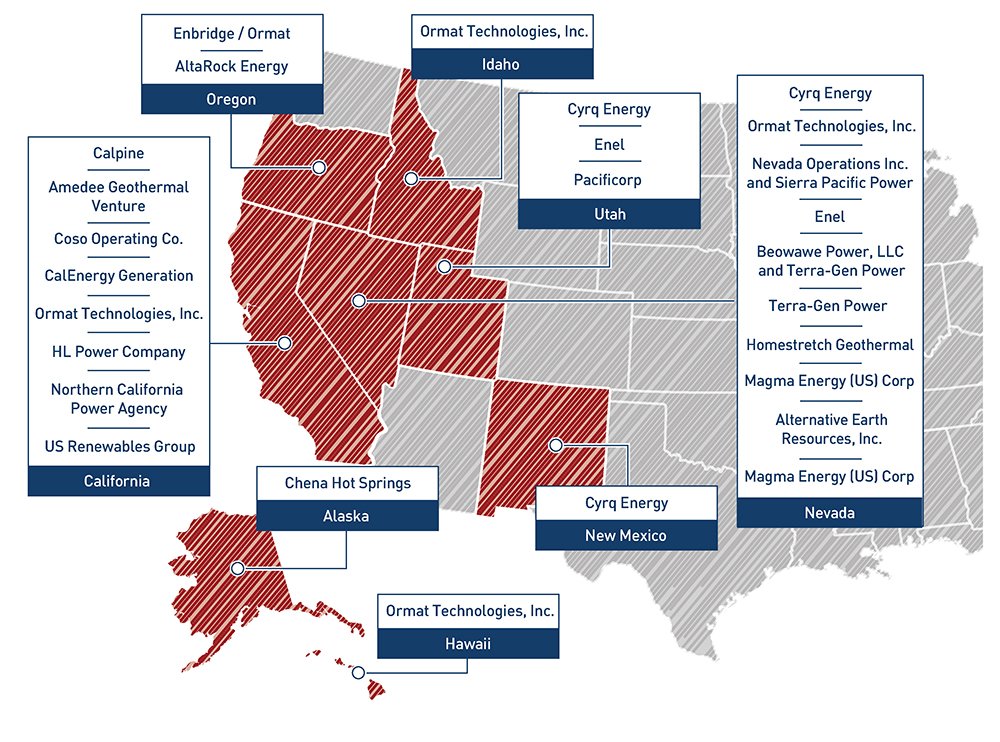
The federal government has played a major role in geothermal development. The U.S. Department of Energy (DOE) supports geothermal energy research, development, and demonstration (RD&D) through its Geothermal Technologies Office (GTO), which is subdivided into four program areas: EGS, hydrothermal resources, low-temperature and co-produced resources, and systems analysis (which broadly studies geothermal barriers and progress). Two of the most significant initiatives supported by GTO, both focused on EGS, are the Frontier Observatory for Geothermal Research (FORGE) program and EGS Collab. FORGE is a multi-million dollar EGS field laboratory and experimental site in Milford, Utah, operated by a coalition of academic, private sector, and governmental entities led by the University of Utah.24 EGS Collab is a small-scale field site that focuses on testing and validating modeling activities in EGS.25 In addition to this work, GTO currently supports five EGS demonstration projects led by private-sector and academic entities (as illustrated in Figure 9, below). GTO also has supported feasibility studies for six deep-direct use research projects in previously untapped regions in states such as New York and West Virginia.26 The map below (Figure 8) illustrates the extensive network of geothermal RD&D resources throughout the U.S.
Figure 8: Existing Geothermal RD&D Project Locations
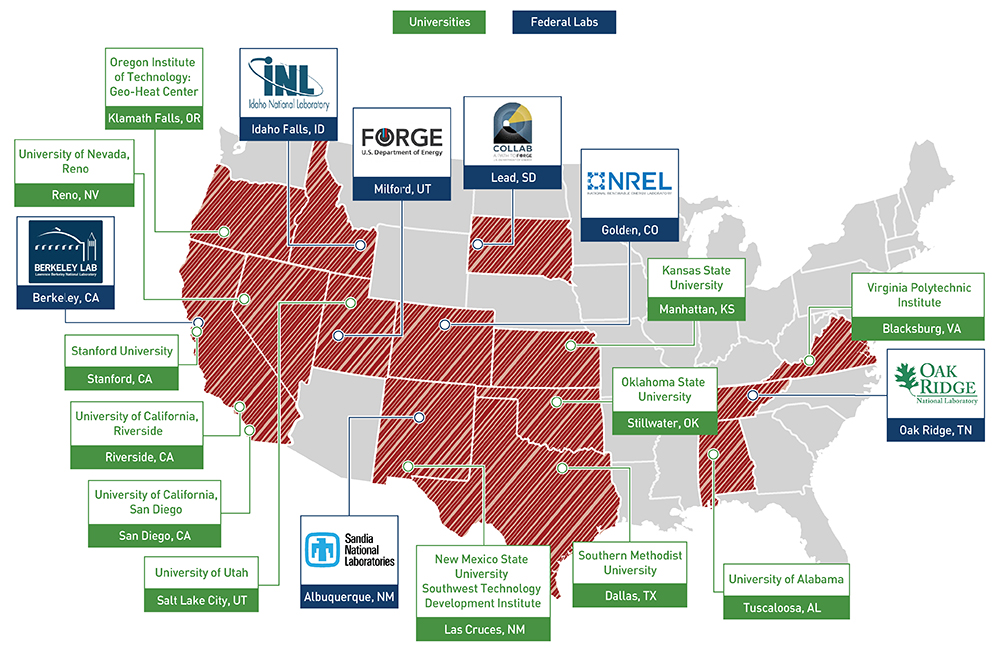
Figure 9: DOE-supported EGS Demonstration Projects
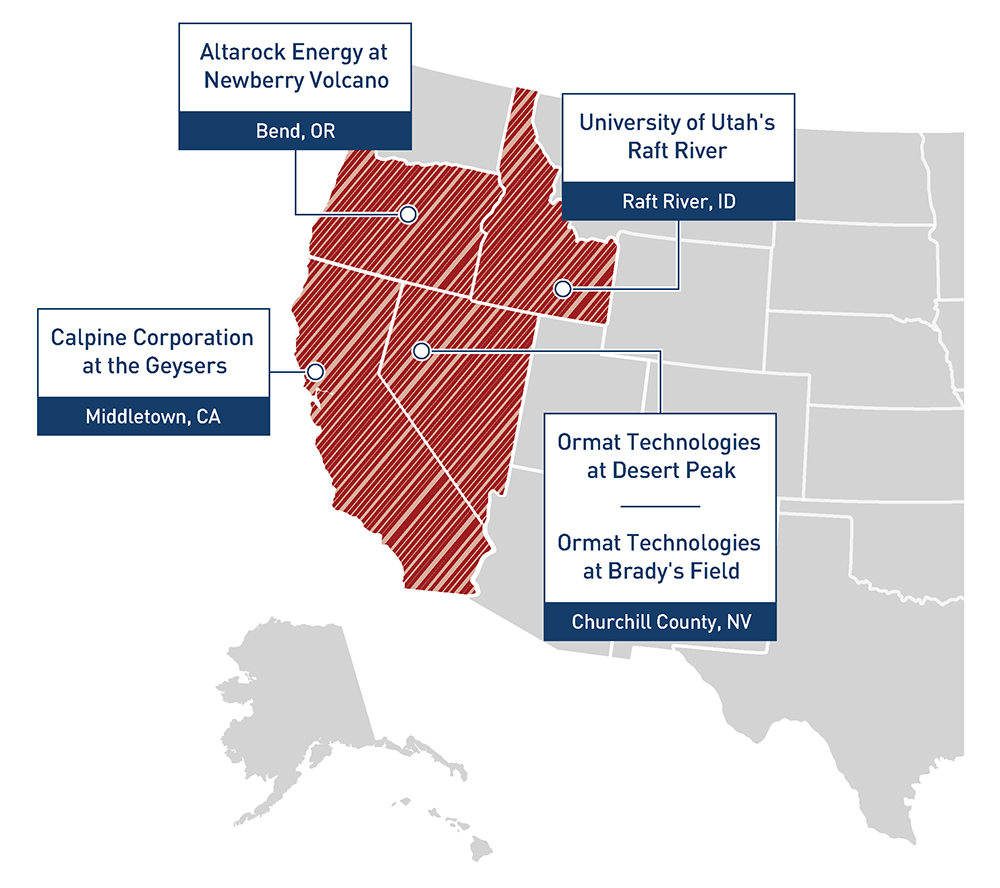
The U.S. leads the world in geothermal electricity generation, producing 19 GWh in 2017.27 A geographically diverse set of countries elsewhere in the world has developed geothermal energy, typically where there are high concentrations of traditional hydrothermal resources. These include Indonesia, the Philippines, New Zealand, Italy, Turkey, Mexico, Iceland, and Kenya.28 Other countries have been active in advancing EGS, with major demonstration projects conducted by France, the United Kingdom, Japan and Australia in recent decades.29
Geothermal electricity currently accounts for only 0.4% of U.S. utility-scale generation. Total U.S. geothermal capacity, or the electricity that could be generated at one time, is 2.5 GW.30A,30BBut the geothermal potential that could be harnessed is enormous: an estimated 30 GW of undiscovered hydrothermal resources and over 5000 GW of EGS resources.31A,31B,31C The levelized cost of electricity for new geothermal power is 22 cents/kWh, compared to 5 cents/kWh for onshore wind and 6 cents/kWh for solar photovoltaic.31 These costs are expected to decrease as geothermal energy is more widely deployed. GeoVision estimates that with technology and regulatory improvements, hydrothermal geothermal generation could double and EGS resources could advance from a negligible share of national electricity generation to providing 8.5%, or even twice that if natural gas prices are high.33
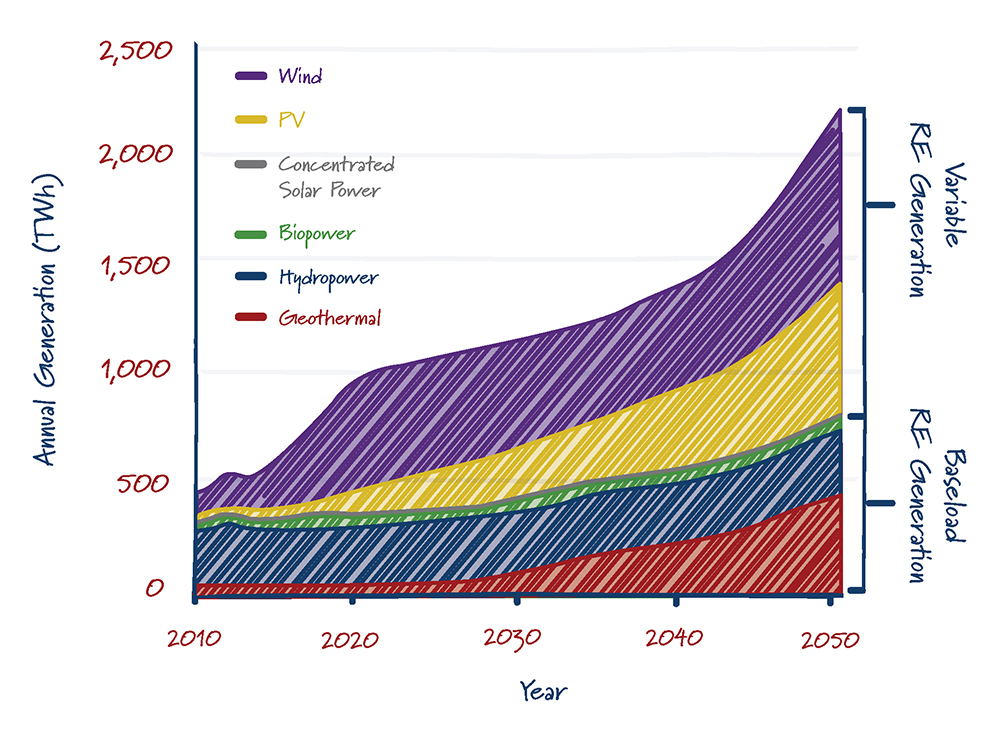
Despite geothermal energy’s enormous potential and benefits, it has contributed only modestly to U.S. and global energy needs. The growth of the geothermal industry has been hampered by a number of surmountable technical and non-technical barriers.
There are many steps the federal government can take to help the industry overcome these barriers and unlock the potential of this resource. Broadly, the federal government should play a role in convening collaborative efforts in addition to leading RD&D of innovative geothermal technologies. The following list, organized by geothermal technology, highlights opportunities for the federal government to accelerate innovation and deployment.40
![]()
Barrier: Existing power purchasing agreement (PPA) structures disadvantage geothermal projects’ access to the power market.
Utility procurement practices typically do not appropriately value the benefits that geothermal power provides. For example, when utilities or wholesale retailers model the levelized cost of electricity of a resource, they do not account for cost savings associated with geothermal energy, including flexibility, reserve capacities, insulation from fluctuating fuel prices, and plant life, which may exceed typical planning periods of thirty years. The benefits associated with geothermal energy could reduce risk associated with their long development timelines and PPAs.
Solution:
![]()
![]()
Barrier: Financing geothermal projects is risky because of uncertainties around resource viability.
Banks typically only finance projects once developers have confirmed that they will be able to successfully develop a resource with a precise degree of confidence. Exploratory drilling is expensive, time consuming, and only leads to full-sized development wells in less than one third of all cases.41 Innovation in technologies for subsurface characterization could enable more reliable development of geothermal resources. Moreover, the geothermal energy industry and federal R&D programs are isolated from other sectors that face similar technical and financing challenges, such as oil and gas.
Solutions:
![]()
![]()
Barrier: EGS resources cannot yet be reliably developed in varying geologies.
Technological innovation is needed to solve unique challenges associated with EGS resource development. EGS technology must be reliable and durable enough to handle high flow rates while operating in exceptionally hot and high-pressure subsurface environments.43
Solutions:
![]()
![]()
Barrier: Slow and cumbersome permitting processes limit geothermal development.
Federal and state permitting processes are ill-equipped to enable permitting of geothermal projects with reasonable costs and timelines. There is a lack of coordination among relevant state and federal permitting offices, and the process can require up to six separate environmental reviews, with varied timelines ranging from a few months to a few years for each permit.
Solution:
![]()
![]()
Barrier: Technologies for GHPs and district heating systems remain expensive.
GHP technologies are relatively mature, but still have high upfront costs. They could be installed more cheaply and widely if system performance was improved and more efficient, lower-footprint drilling technologies were developed.44 District heating technologies face the same barriers as geothermal electricity production, plus the challenge of locating resources close to populated centers and integrating them with diverse existing infrastructures.45
Solution:
![]()
![]()
![]()
Barrier: Geothermal technologies have not benefited from renewable energy policies that would enable them to achieve economies of scale.
Geothermal power and heating applications remain expensive in part because they have not benefited from the same federal renewable energy policies that have allowed wind and solar to rapidly expand and achieve economies of scale, such as the Investment Tax Credit (ITC) and Production Tax Credit (PTC). While geothermal energy qualifies for the PTC and ITC, the long-term uncertainty that has historically surrounded these tax credits has disadvantaged it because geothermal projects can take nearly a decade to develop.
Solution:
![]()
![]()
![]()
Barrier: Low public awareness has slowed the adoption of geothermal technologies.
There is a lack of public awareness and understanding of geothermal energy, including its availability as a renewable resource.46 This lack of awareness has likely contributed to the absence of federal and state policies supporting geothermal energy, and low interest from consumers and businesses in acquiring small-scale geothermal technologies such as GHPs.47
Solutions:
